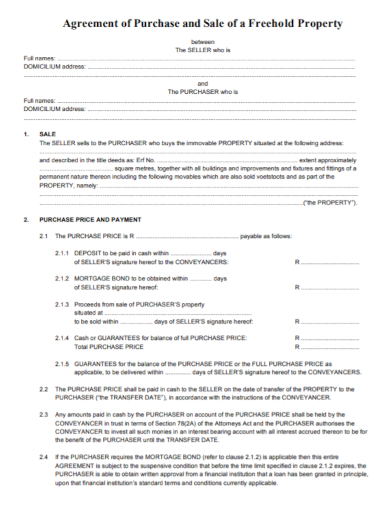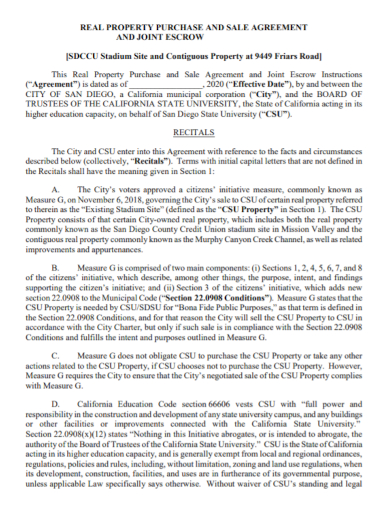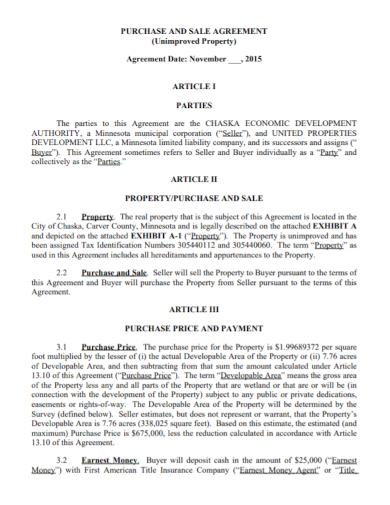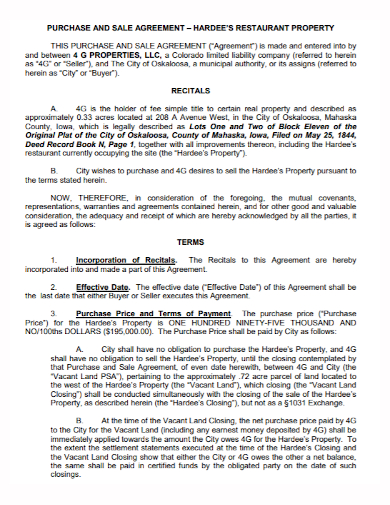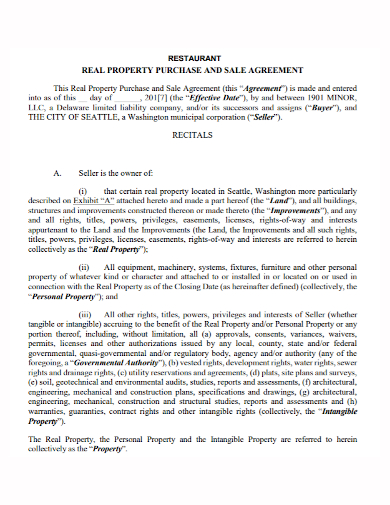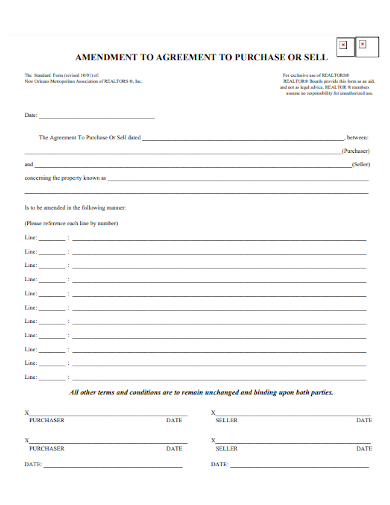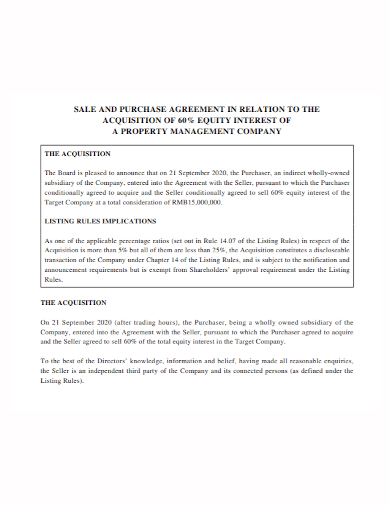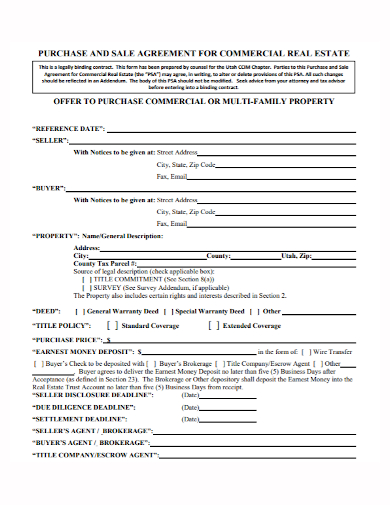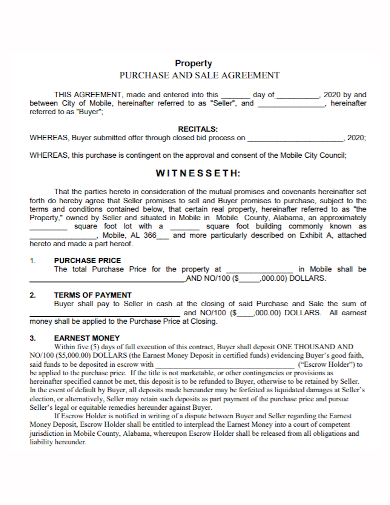The sale and purchase agreement essentially spells out all of the details of the transaction so that both parties are on the same page. The purchase price, the closing date, the amount of earnest money that the buyer must submit as a deposit, and a list of items that are and are not included in the sale are all terms that are typically included in the agreement. One of the most important documents in a business owner’s life is the sale and purchase agreement. As a result, it should be approached with caution and rigor, with legal professionals guiding both the seller and the buyer.
10+ Property Sale and Purchase Agreement Samples
A Sale and Purchase Agreement (SPA) is a legally binding contract that outlines the buyer and seller of a property’s agreed-upon terms (e.g., a corporation). It is the most important legal document in any sale transaction. In essence, it lays out the agreed-upon terms of the transaction, provides a number of important safeguards for all parties involved and establishes the legal framework for the sale to be completed. As a result, the SPA is critical for both sellers and buyers.
1. Property Sale and Purchase Agreement Template
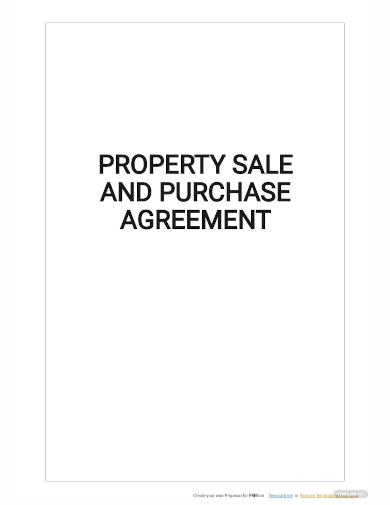
2. Real Estate Property Purchase and Sale Agreement
3. Freehold Property Purchase and Sale Agreement
4. Real Property Purchase and Sale Agreement
5. Unimproved Property Purchase and Sale Agreement
6. Restaurant Property Purchase and Sale Agreement
7. Restaurant Real Property Purchase and Sale Agreement
8. Amendment to Purchase and Sale Property Agreement
9. Company Property Sale and Purchase Agreement
10. Commercial Property Sale and Purchase Agreement
11. Sample Property Sale and Purchase Agreement
Features and Provisions
- Parties to the agreement – There are only two parties to the agreement in the simplest form of a sale, in which a company is wholly owned by a single person or parent company and is bought by a single buyer. When a company is sold, however, there may be additional parties involved, such as multiple shareholders. To sell their shares in these situations, each shareholder must enter into a sale and purchase agreement.
- Agreement to sell and purchase – This is frequently the SPA’s shortest and most basic provision. It is, however, one of the most important because it ensures that full legal ownership of the shares (also known as “title”), as well as all relevant rights attached to the shares, is properly transferred (e.g., rights to dividends). This clause usually also states that the shares are free of encumbrances, assuring the buyer that the seller has not pledged any of the shares to a bank or other lender.
- Consideration – Buyers pay cash, debt (such as a promissory note issued by the buyer), stock in the buyer, or a combination of these to a seller in exchange for an acquired company.
- Restrictive covenants – The buyer will want to keep the seller from starting a new competitive business that will depreciate the value of the business being sold. As a result, the sale and purchase agreement will include restrictive covenants prohibiting the seller from soliciting existing customers, suppliers, or employees, as well as from competing with the company being sold in general (for a specified time period and within specified geographic regions). In terms of geography, scope, and duration, these restrictive covenants must be reasonable. Otherwise, they may be breaking the law of competition.
- Warranties – Warranties are statements of fact made in the SPA by a seller about the condition of the company being sold. If a warranty turns out to be false and the company’s value plummets, the buyer may be able to sue for breach of warranty. The company’s assets, accounts, material contracts, litigation, employees, property, insolvency, intellectual property, and debt are all covered by warranties.
- Conditions precedent – The preferred and simplest method of concluding a deal is simultaneous signing and completion (where both parties sign the SPA and close the sale on the same day). However, in order to satisfy certain final outstanding conditions, a time gap between signing and completion may be required. These are known as “conditions precedent,” and they typically include clearances from tax authorities, merger approval from authorities, and third-party consent.
- Completion – When legal ownership of the shares transfers to the buyer, the buyer becomes the owner of the target company. A completion schedule in the SPA will typically list all of the documents that must be signed as well as other actions that must be taken in order for the deal to be completed.
- Post completion – Following the completion of the transaction, the sale and purchase agreement remains an important reference document because it details how an earn-out will be handled and contains restrictive covenants, confidentiality obligations, warranties, and indemnities, all of which may be very important in the future.
FAQs
What is a short sale in real estate?
In real estate, the term “short sale” refers to a transaction in which a financially distressed homeowner sells their home for less than the amount owed on their mortgage. The property is purchased by a third party (not the bank), and all proceeds go to the lender. The lender has two options: forgive the remaining balance or pursue the homeowner through a deficiency judgment, which requires the homeowner to pay the lender the difference in full or in part. In some states, a short sale must legally forgive this difference.
What is foreclosure?
The act of a lender seizing a home after the borrower fails to make payments is known as a foreclosure. For the lender, foreclosure is the last resort. Foreclosures, unlike short sales, are initiated solely by lenders. The lender takes action against the delinquent borrower in order to force the sale of a home in order to recoup its mortgage investment. In addition, unlike most short sales, many foreclosures occur after the homeowner has abandoned the property. If the occupants remain in the house, the lender will evict them.
If you want to see more samples and formats, check out some property sales and purchase agreement samples and templates provided in the article for your reference.
Related Posts
FREE 10+ Mentoring Agreement Samples In MS Word | Apple Pages | PDF
FREE 10+ Partner Agreement Samples In MS Word | Google Docs | Apple Pages | PDF
FREE 10+ Individual Agreement Samples In MS Word | Google Docs | Apple Pages | PDF
FREE 10+ Strategic Agreement Samples In MS Word | Google Docs | Apple Pages | PDF
FREE 10+ Equity Agreement Samples In MS Word | Google Docs | Apple Pages | PDF
FREE 10+ Producer Agreement Samples in MS Word | Apple Pages | PDF
FREE 10+ Grant Agreement Samples In MS Word | Apple Pages | PDF
FREE 8+ Meeting Agreement Samples in MS Word | Google Docs | Apple Pages | PDF
FREE 10+ Community Agreement Samples In MS Word | Google Docs | PDF
FREE 8+ Real Estate Option Agreement Samples in MS Word | PDF
FREE 10+ Call Option Agreement Samples In MS Word | PDF
FREE 10+ Advertising Agreement Samples In MS Word | Google Docs | Apple Pages | PDF
FREE 10+ Car Agreement Samples In MS Word | Google Docs | Apple Pages | PDF
FREE 10+ Horse Agreement Samples In MS Word | Apple Pages | PDF
FREE 10+ Option Agreement Samples In MS Word | Google Docs | Apple Pages | PDF


